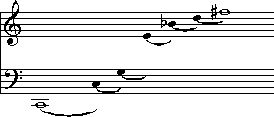Composers and their Music: Olivier Messiaen
COMPOSERS AND THEIR MUSIC
NO.1: OLIVIER MESSIAEN, 1908 - 1992
Biography - Ian le Prévost
Born in Avignon in 1908, Olivier Messiaen was to become one of the most individual composers of the twentieth century, developing a harmonic and melodic language that was, for some, to come to be regarded as the epitome of the bond that exists between music and spirituality. Regarded by many as France's greatest living composer, for sixty years he was at the forefront of a period in which music and its language was to change more quickly and fundamentally than in any other period in history; Messiaen was a chief protagonist in that period, both as a composer and as a teacher. His works are richly varied, but underlying all is a deep spirituality that is rooted in his ardent Christian beliefs and his deep love for nature, which he regards as God's masterpiece. His later music is inspired by the sounds of nature, and, in particular, birdsong, which he regarded as the most natural of all music.
His father, Pierre, was renowned as a translator of Shakespeare's plays; his mother, to whom he felt a close affinity, was the poet Cécile Sauvage.
Living what he described as a solitary childhood, surrounded by poetry or stories of enchanted worlds, Messiaen did not understand why he felt drawn towards music. The family had a piano, which he began to play, and he would often spend his time experimenting with good harmonies and melodies; he even wrote canons.
With the outbreak of war in 1914, and the call-up of Pierre Messiaen, the family went to stay at Grenoble, in the Dauphiné mountains, a constant source of inspiration throughout his life as a composer. During these years, he started piano lessons, playing pieces that he bought from the town's large music shop, Deshairs. He would take any opportunity to get musical scores, receiving them as presents, but also saving money to buy them. One work that he bought and loved immensely, was Grieg's Peer Gynt; influenced by folklore, its appeal was its flowing melodic lines, which gave him his love of melody. His music teacher, who earned his living by giving lessons, never let him pay. When, at the age of eleven, Messiaen left him to go to Paris, he was given a score of Debussy's Pelléas et Mélisande, which he described as a revelation:
Debussy's music is like water. Water is still and doesn't move, but if you throw a stone in, there is an immediate shock wave around the stone and the water starts moving. Debussy's music is like that. There are sudden pauses and all of a sudden it moves. It was the pauses that struck me.
In 1919, his father was appointed a teacher at the lycée Charlemagne in Paris, where Messiaen's musical education continued, joining the Paris Conservatoire that same year, where he studied until 1930. Although he took organ with the renowned Marcel Dupré, piano with Georges Falkenburg, and history with Maurice Emmanuale, he regarded the training received from Paul Dukas as essential to his achievements as a composer. Dukas taught him form and structure, but, more importantly, orchestration, and it was whilst he was in that class that he wrote his first major compositions, the Huit Préludes pour Piano.
Messiaen gave Dupré much credit for his lifelong interest in the organ as both a composer and a performer, and, at the age of 22, he became organist at the Paris Church of La Trinité, where he was to remain for the rest of his life. His first major composition for organ, L'Ascension, written in 1934, was an adaptation of an earlier work for orchestra. In four movements, it portrays the mystery of Christ's ascension into Heaven; one movement of the orchestral suite, Alléluia sur la trompette, alléluia sur la cymbale became transplanted by Transports de joies, which was to become one of Messiaen's most famous organ works.
The advent of war in Europe was to seriously disrupt Messiaen's life as a musician, but also led to the composition of one of his most appealing works; whilst serving as an orderly in a French army hospital he was captured by the Germans and held prisoner for a year. There he suffered terrible deprivations - food was scarce and prisoners were provided with just enough to keep them alive. He gave a lecture to the camp's priests' section on the colours of the Apocalypse and was, in particular, struck by the Angel of the Apocalypse that announces the end of time. This event heralded his Quatuor pour la fin du temps for other musicians in the camp who were incarcerated with him: a violinist, Henri Leboulaire, a clarinettist, Henri Acoca and a famous cellist, Etienne Pasquier. With himself as pianist, the first performance took place in the Stalag. Messiaen described the first performance as 'horrible' - the piano keys stuck, the cello had only three strings and the clarinet had a jammed key. 'It was a horrible performance and the people there knew nothing about music, but since we were all companions of misfortune, they were enthusiastic… it was a moment of deliverance for those unhappy hungry people.'
Repatriated in 1942, Messiaen returned to the Trinité, and joined the staff of the Paris Conservatoire as Professor of Harmony, a post he was to hold for the next forty or so years. Many of his students went on to become renowned composers themselves, Pierre Boulez, Karl Heinz Stockhausen and George Benjamin amongst them. One student in particular, however, was to play a vital role in his works as a musician, the pianist Yvonne Loriod. She was to become the principal interpreter of his piano music, and it is not surprising that the piano began to feature more prominently in his output. Two prominent piano works appeared in 1943 and 1945: Visions de l'Amen for two pianos, and Vingt regards sur l'Enfant-Jésus. In 1944 came the publication of his treatise, Technique de mon language musical and four years later he composed his only symphony, the massive Turangalîla-Symphonie for Serge Koussevitzky and the Boston Symphony Orchestra, premiered by Leonard Bernstein in December 1949.
Messiaen continued in his role at the Conservatoire, ultimately becoming Professor of Composition in 1966. Until this time and beyond, he travelled the world teaching composition, analysis and rhythm, and on the death of his first wife in 1962, he married Loriod. His large-scale work, the opera St François d'Assise, took several years to complete. Finished and premiered in 1983, it was to be his last large-scale work. He remained working as both a teacher and composer until his death in May 1992 at the age of 83.
2. An Overview of Messiaen's Musical Language, by Gareth Healey
In 1944, Messiaen published his Technique de mon language musical, a treatise explaining his musical language up to that point, which appears to be a unique synthesis of various disparate elements. Since nearly all his works are based on a formulated musical language, a thorough examination of it is vital in forming a complete understanding of them. With the exception of his later, more detailed, excursions into birdsong and serialism, all his techniques are manifest in Vingt regards sur l'Enfant-Jésus, and in certain cases, such as the third Regard, 'L'échange', dominate individual pieces. Thus, the piano cycle has been chosen to provide the majority of examples in this section.
Modes of limited transposition
In Technique of my musical language (1944: 59-62), Messiaen lists seven modes:

To hear these modes, click here.
Although Messiaen was the first composer to categorise and name these modes, the origins of only Modes 1 and 2 can be traced further back. (It should be noted that these have nothing to do with other modes of India, China, Ancient Greece and plainchant.) Mode 1, uniquely among the seven, does not contain a semitone step; composers such as Glinka and Liszt had used this whole-tone scale as early as the 1830s, but not in such a systematic way. Its presence in a series of modes of limited transposition is explained by the fact that it can only exist in two transpositions:
First transposition - C, D, E, F#, G#, A#
Second transposition - Db, Eb, F, G, A, B
The limitations provided by the whole-tone scale, allied to the fact that it had been used so often before, meant that Messiaen used it less than the remaining modes. (For this same reason it was deliberately avoided by Ravel.) As Messiaen explained:
Claude Debussy, in Pelléas et Mélisande, and after him Paul Dukas, in Ariane et Barbe-Bleue, have made such remarkable use of it that there is nothing more to add. Then we shall carefully avoid making use of it, unless it is concealed in a superposition of modes which renders it unrecognisable (1944, 59).
Liszt, Rimsky-Korsakov, Scriabin, Debussy, Ravel and Stravinsky had also used Messiaen's second mode: Rimsky-Korsakov employed it more simply as an octatonic scale of alternating tones and semitones, whereas its use by Stravinsky was more frequent and systematic. Similarly, it is Messiaen's favourite and thus the most used of the seven. First used in the fifth Prélude, Les sons impalpables du rêve (1929), the mode consists of four symmetrical overlapping groups of three notes, each group containing a semitone followed by a tone. This allows three transpositions thus:

To hear these transpositions, click here.
The theory of these transpositions is demonstrated below, which shows that when the second mode is transposed for a fourth time, it returns to the same notes as those of the first transposition (enharmonically speaking), highlighting that only three transpositions are possible.

Messiaen compares the second mode to the chord of the diminished seventh (which it outlines), as it too has only three transpositions.
Mode 3 is transposable four times and contains different groupings from those in Mode 2; three symmetrical groups of four notes each have the interval of a tone followed by two semitones. Its transpositions work in a similar way to the examples shown above.
Mode 4 differs from the previous three since, as the following example shows, it contains only two symmetrical groups. Therefore, a total of six transpositions is possible.

Modes 5, 6, and 7 work in the same way; these four modes form a similar group, but, due to their limitations, they were favoured less.
Non-retrogradable rhythms
These are palindromic rhythms. For example:

Messiaen gives two definitions of non-retrogradable rhythms:
- 'Whether one reads them from right to left or from left to right, the order of their values remains the same'.
- 'All rhythms divisible into two groups, one of which is the retrograde of the other, with a central common value, are non-retrogradable' (1944, 20).

To hear this example, click here.
Added values
An added value is where an addition to a rhythm makes its value irregular. Much favoured by Messiaen, this technique allows him to build prime-numbered groupings from an even-numbered rhythmic cell, making Messiaen's rhythms both flexible and unpredictable. A very common occurrence of added value is shown below.

Rhythmic canons
These are similar to normal canons, but the element of pitch is not involved. There can be two or more entries, with each a prescribed distance apart. To qualify as a rhythmic canon, each entry must have the same rhythm, but not the same pitch. Entries in the following example are at the distance of a crotchet.

Rhythmic pedals
These ostinato figures repeat a set rhythm as many times as is required; the rhythm of the pedal can be, and often is, entirely independent from any of the other rhythms involved. The following example has four pedals, marked A, B, C and D.

Play
Added notes
This technique derives from Debussy. Messiaen mentions finding in Debussy 'appoggiaturas without resolution, of passing notes with no issue .... foreign notes, with neither preparation nor resolution, without particular expressive accent, which tranquilly make part of the chord, changing its colour, giving it a spice, a new perfume .... they are added notes' (1944: 47). The added sixth and augmented fourth are important parts of Messiaen's language (the chord of F-sharp major with an added sixth forms the harmonic basis of the Vingt regards), so his explanation is worth quoting in detail. The first stage is to add a sixth to a chord:

Play
A seventh and then a ninth can be added:

Play
Messiaen then argues that the next note in this harmonic sequence should be an F sharp:

Play
The final result is a chord containing a sixth and an augmented fourth that resolves to a chord with an added 6th:

Play
Agrandissement asymétrique
Messiaen uses this technique to develop a small cell through the alteration of pitches by various means. Some pitches rise, some fall, and some remain the same, a technique that can be found in the fugal subject of the sixth Regard, 'Par Lui tout a été fait', but its most extended use occurs in the third Regard: 'L'échange', which is almost entirely based on this technique. The octaves in groups of three on the lowest stave progress using agrandissement asymétrique. The following shows the start of the procedure:

Birdsong
Messiaen had a life-long interest in birdsong: he was an expert amateur ornithologist and used this knowledge in his composition. Messiaen was not the first composer to try to represent birdsong in pianistic terms, and there are well-known examples that pre-date Messiaen by many years such as Liszt's second Legend - 'St Francis of Assisi preaching to the birds.' However, Messiaen's approach is different in that his quest for accuracy is far greater since he wants to produce a true recreation of nature rather than merely hinting at it. Messiaen's style of birdsong writing developed throughout his career, demonstrated by comparing an earlier use of birdsong in 'Regard des Hauteurs' - the eighth of Vingt regards sur l'Enfant-Jésus - with any of the pieces from Catalogue d'oiseaux (1956-8).
Hindu rhythms
In Technique de mon langage musical, Messiaen explains that the thirteenth-century Hindu theorist Carngadeva produced a table of 120 deçi-tâlas that was reproduced in the Encyclopédie de la musique et dictionnaire du conservatoire, (edited by Lavignac and La Laurencie and published in Paris between 1913 and 1931 [Part 1, Volume 1, pp 301 ff]). Messiaen did not carry out any extensive research into Indian music in general, but was fascinated nevertheless by these, and their possibilities. They became one of the fundamentals of his musical language and he made extensive use of them in all aspects of his music.
Greek metres
Messiaen's interest in Greek metres began during his student years at the Conservatoire. His music history teacher during this period, Maurice Emmanuel, had an extensive knowledge of Greek metres and wrote an article on the subject in the Encyclopédie de la musique et dictionnaire du conservatoire; as with the Hindu rhythms, this book was Messiaen's prime source on the subject. The bases of these metres are the two values which combine to each make one:
Rhythmic augmentation and diminution
The augmentation and diminution of rhythms are procedures used by Messiaen to vary and add interest to rhythms and thus make them less predictable. In Technique de mon langage musical, Messiaen states that J. S. Bach used these methods, although in the simplest ways. The following shows how simple augmentation works:

A has the value of 5 semiquavers
B has the value of 5 quavers
C has the value of 5 crotchets
Therefore, B is an augmentation of A, and C is a varied double augmentation of A. The following demonstrates how augmentation through the addition of a dot to a note works:

Simple diminution and diminution by withdrawal of the dot work in the opposite way to the above examples.
Personnages rythmiques
The concept of personnages rythmiques is derived from Stravinsky's The Rite of Spring. Each personnage is a short rhythmic cell that has certain constituent elements, which include mobility and immobility, and for which their juxtaposition is the basic idea. Although a mobile cell is one that can either increase or decrease in value, immobile cells always remain constant. Messiaen noticed how Stravinsky manipulates rhythmic cells in The Rite of Spring (particularly in the 'Sacrificial Dance', which is the most complex section), and compared the various cells to theatrical characters. In his analogy, Messiaen compares a cell which increases in value to a character who dominates the scene (the one who does the acting), the cell which decreases to a character who is acted upon, and the immobile cell to a motionless character who observes the scene. This led to Messiaen giving the technique the name personnages rythmiques. Although in Vingt regards there is no clear example of this technique, its influence can be seen throughout, in passages that contain at least two rhythmic cells, where one increases while the other decreases. One example occurs in 'Par Lui tout a été fait'. In Vingt regards, Messiaen employed Stravinsky's initial concept; however, later works, such as the Turangalîla-Symphonie, employ a more developed approach. For this reason alone, personnages rythmiques must be considered a vital part of Messiaen's musical language.
Conclusion
These techniques take on an overall cohesion when their relationships are examined. In many instances a technique can be applied both harmonically and rhythmically (or vertically and horizontally), producing paired relationships. They are as follows:
- Modes of limited transposition and Non-retrogradable rhythms are built on symmetrical patterns. According to Messiaen: 'The modes of limited transposition realise in the vertical direction (transposition) what non-retrogradable rhythms realise in the horizontal direction (retrogradation)' (1944, 62).
- Added values are the rhythmic equivalent of the harmonic added notes.
- Asymmetric augmentation is the harmonic (and vertical) equivalent of the rhythmic (and horizontal) Personnages rythmiques, to which can be added the relationship between polyrhythms (the superposition of rhythms) and polymodality (the superposition of modes). These types of relationship are called by Messiaen the 'Charm of Impossibilities'.
- Non-retrogradable rhythms can also be applied to the area of form, resulting in a non-retrogradable structure.
- Rhythmic augmentation and diminution form a pairing, as do Rhythmic canons and Rhythmic pedals, which are based on the same principle. This collection of techniques contains a number which were used by previous composers; some are adaptations and the rest are entirely of Messiaen's own invention. Nevertheless, they provided him with a comprehensive, contemporary compositional system.
